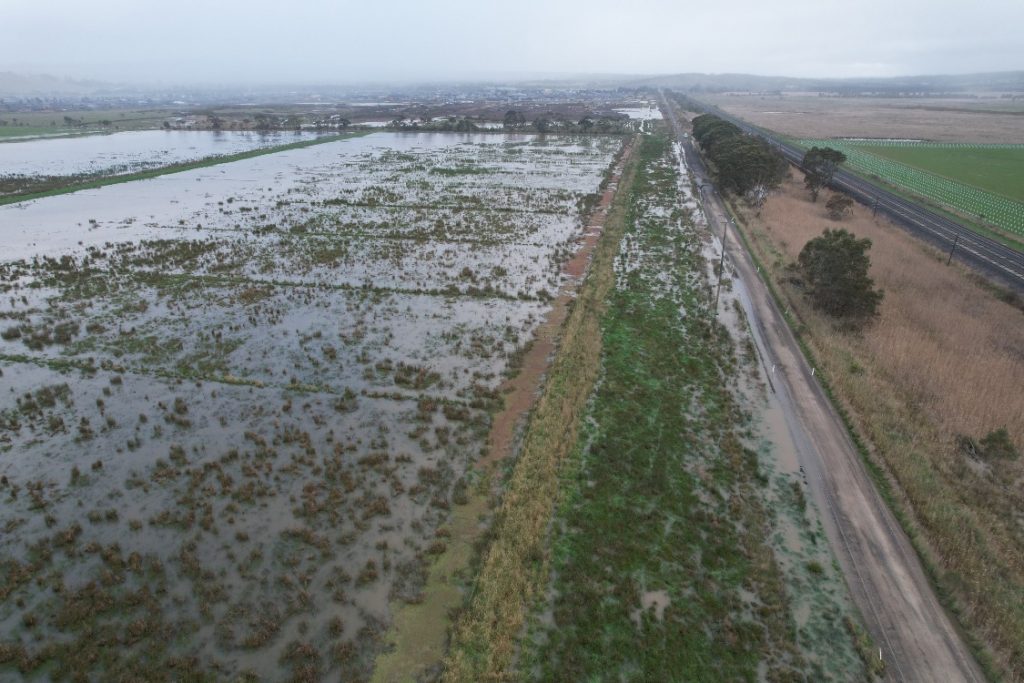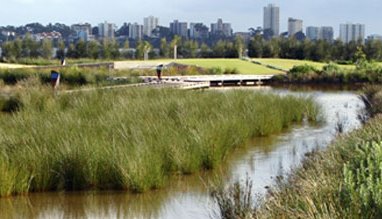Another glimpse of Herne Swamp – Highlighting the potential role of multi-purpose restored natural wetlands in urban development
Over the past couple of years, we’ve been exploring the potential for natural wetlands to be restored and enhanced as part of the land-use change process initiated by urban development. For more information on past stories, please follow this link.
To highlight this potential, a recent rainfall event north of Melbourne at Wallan, has caused the temporary re-appearance of Herne Swamp. The nearby Kilmore Gap weather station recorded a relatively modest rainfall event of 52.2 mm over the weekend of the 4th and 5th of September 2021, which was responsible for this degree of inundation.
However, what you see here is only temporary because, while the minor agricultural drainage network which was cut many decades ago into the bed of the swamp is easily overwhelmed during high inflows, as inflows recede, the drains soon ‘catch up’ – effectively draining the water from the natural surface of this wetland feature – sending a big artificial pulse of water downstream.

Along with nearby, also currently degraded and artificially drained upstream wetlands to the west (Meade Swamp and Hanna Swamp), this former, large (600+ ha) in-stream floodplain wetland at the headwaters of Merri Creek, could play a vital role in moderating the effects of current and future urbanisation in this area, on the waterway downstream – not to mention the predicted impact of climate change on weather patterns and rainfall events. With increased urbanisation comes the risk of flashier flows impacting on water quality and waterway health, so this is a big issue!
Imagine if modest rainfall events like this could be harnessed and used to reinvigorate previously degraded wetlands, for multiple benefits?
One of the big opportunities that is presented by a wetland that has been highly modified in the past, is that we need not be as constrained in how the wetland can be used in the future and potentially integrated as a waterway asset into development drainage schemes (compared to more pristine sites where changes in hydrology might be detrimental). Rather than being viewed purely as a potential biodiversity asset, these projects can and should be about so much more.

Take a look at the adjacent urbanisation in the image above. Most of Herne Swamp is required to be kept as open space because this will always be flood-prone land, but the regularity, depth and nature of inundation is going to be entirely dependent on the way adjacent developments are designed to interact with this floodplain wetland.
We now get to choose whether Herne Swamp in the future will consist of dry, weedy paddocks most of the year (but occasionally go under water for a few days at a time after heavy rainfall), or become something else entirely. Something a bit more inspiring.

Imagine a situation where those future nearby residents have access to a natural open space with a vast, shallow vegetated wetland and returned wildlife. A restored wetland that slows the flow and increases infiltration rates while helping to clean up stormwater for their new suburb – all the while providing downstream flood protection and water quality improvements. Improved aesthetics, liveability and urban cooling – not to mention the educational opportunities (including Indigenous cultural heritage) for the future school proposed nearby – the list of potential benefits is a long one.
If you were visiting your family and friends who move to this new outer urban development north of Melbourne, what future suburb would you wish for them?
Decisions about the way that development interacts with features like Herne, Meade and Hanna Swamp are made many years – sometimes decades – ahead of the actual works. Important conversations about the future of these wetlands continue at the present time.
Finally, if you would like to have a say on the future of Melbourne’s Waterways and Wetlands, it is also worth mentioning that Melbourne Water have a series of workshops coming up in early November as part of Healthy Waterways Strategy Forum Week. If you are interested to participate, I would recommend that you register to attend by following this link.
